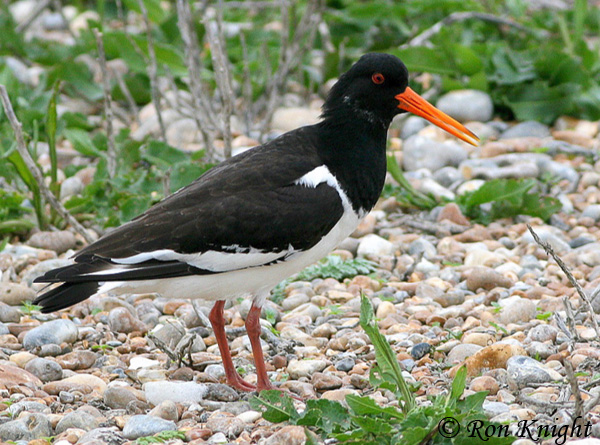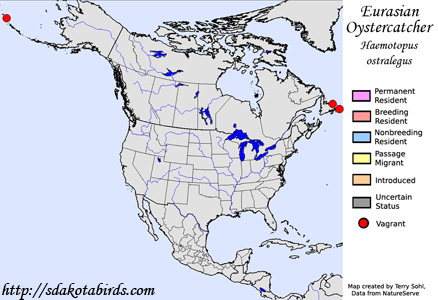| Length: 16-18 inches | Wingspan: 30-34 inches | Seasonality: Non-resident in South Dakota |
| ID Keys: Black upperparts, white underparts, characteristic long orange bill | ||
 The
Eurasian Oystercatcher is a very widespread species in Europe and Asia,
where four distinct populations occur. One population breeds from Iceland
eastward to far northwestern Russia, a second is found in the interior of
Asia, primarily in Russia, a third is found in far northeastern Asia from
Kamchatka down through Japan and Korea, while a fourth is found exclusively
in New Zealand (where it is called the "Pied Oystercatcher"). They are
only extremely rare visitors to North America. There are at least two
records in Labrador in far southeastern Canada, and in 2012, a single bird
was found on Buldir Island in the Aleutian Islands of Alaska. They are
similar overall in appearance to North America's
American Oystercatcher.
The
Eurasian Oystercatcher is a very widespread species in Europe and Asia,
where four distinct populations occur. One population breeds from Iceland
eastward to far northwestern Russia, a second is found in the interior of
Asia, primarily in Russia, a third is found in far northeastern Asia from
Kamchatka down through Japan and Korea, while a fourth is found exclusively
in New Zealand (where it is called the "Pied Oystercatcher"). They are
only extremely rare visitors to North America. There are at least two
records in Labrador in far southeastern Canada, and in 2012, a single bird
was found on Buldir Island in the Aleutian Islands of Alaska. They are
similar overall in appearance to North America's
American Oystercatcher.
Habitat: Found in a the vicinity of a wide variety of aquatic habitats. Coastal populations can be found on rocky shorelines, sandy beaches, river estuaries, or shoreline cliffs. Populations found inland are found in and around lake and river shorelines.
Diet: Eurasian Oystercatchers are specially adapted to feeding on shellfish. They will also feed on worms, insects, crustaceans, and other small invertebrates if available.
Behavior: Foraging behavior depends upon location and prey source. In coastal areas, much of the feeding is done in the intertidal zone, where limpets and other shellfish are pried off rocks with their bill, cracked open with sharp blows from the bill, and/or pried open to retrieve the meat inside. A preferred method of foraging is to wait for mussels and other shellfish to be actively filter feeding, with the two shell halves open. With a quick dart of their bill, Oystercatchers pierce the opening between the shells and sever the muscle that controls closing of the shell, disabling the shellfish's ability to close the shell and protect itself.
Nesting: Eurasian Oystercatchers are thought to mate for life. The nest is a simple depression, built on the sand, amongst a rocky shoreline, or in a vegetated grassy area. Any nest construction is sparse, with perhaps a bit of dead vegetation or shells lining the depression. The female lays between 2 and 4 eggs, and both parents help to incubate them. The eggs hatch after about 4 weeks. The young only stay in the nest for a day or two before following the parents around. The parents tend them and feed them for 4 or 5 weeks before the young become semi-independent.
Song: A very vocal species, Eurasian Oystercatchers have a number of calls depending upon context. The most commonly heard is a shrill piping KEEEEP!! that is often repeated several times.
Migration: Most Eurasian Oystercatchers are strongly migratory. Coastal areas are the preferred wintering grounds, including southwestern Europe, the coasts Africa, the Mediterranean, and much of the southern coastline of Asia. A few populations may be permanent residents, such as those in northwestern Europe, or the New Zealand subspecies.
Interactive eBird map: Click here to access an interactive eBird map of Eurasian Oystercatcher sightings
Similar Species: Similar to North America's American Oystercatcher. Leg color differences and minor plumage difference are keys to identifying the two, but in reality, the range of the two species doesn't intersect. Perhaps the only location where a conflict may come into play is Labrador and elsewhere in far southeastern Canada, where both species have appeared as extremely rare vagrants.
Conservation Status: The Eurasian Oystercatcher is found over a very wide geographic area, and is common in parts of its range. In the late 20th century, some populations actually expanded substantially, perhaps rebuilding numbers after declines of the 19th century and early 20th century. However, in the last 15-20 years, populations have declined substantially. Mechanical shellfishing operations in parts of its range are thought to have been one cause of the decline. Despite overall good numbers, the recent declines have led the IUCN to list the Eurasian Oystercatcher as a "Near Threatened" species.
Further Information: 1) Arkive.org - Eurasian Oystercatcher
2) BBC Nature - Eurasian Oystercatcher
3) BirdLife International - Eurasian Oystercatcher
Photo Information: Photo by Ron Knight - licensed under Creative Commons Attribution 2.0 Generic License
| Click below for a higher-resolution map |
 |
| South Dakota Status: Non-resident in South Dakota |
Additional Eurasian Oystercatcher Photos (coming soon!!)
